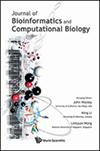A non-parametric Bayesian joint model for latent individual molecular profiles and survival in oncology
IF 0.7
4区 生物学
Q4 MATHEMATICAL & COMPUTATIONAL BIOLOGY
Journal of Bioinformatics and Computational Biology
Pub Date : 2022-09-08
DOI:10.1142/s0219720022500226
引用次数: 0
Abstract
The development of prognostic molecular signatures considering the inter-patient heterogeneity is a key challenge for the precision medicine. We propose a joint model of this heterogeneity and the patient survival, assuming that tumor expression results from a mixture of a subset of independent signatures. We deconvolute the omics data using a non-parametric independent component analysis with a double sparseness structure for the source and the weight matrices, corresponding to the gene-component and individual-component associations, respectively. In a simulation study, our approach identified the correct number of components and reconstructed with high accuracy the weight ([Formula: see text]0.85) and the source ([Formula: see text]0.75) matrices sparseness. The selection rate of components with high-to-moderate prognostic impacts was close to 95%, while the weak impacts were selected with a frequency close to the observed false positive rate ([Formula: see text]25%). When applied to the expression of 1063 genes from 614 breast cancer patients, our model identified 15 components, including six associated to patient survival, and related to three known prognostic pathways in early breast cancer (i.e. immune system, proliferation, and stromal invasion). The proposed algorithm provides a new insight into the individual molecular heterogeneity that is associated with patient prognosis to better understand the complex tumor mechanisms.肿瘤学中潜在个体分子谱和生存率的非参数贝叶斯联合模型
考虑患者间异质性的预后分子特征的开发是精准医学的一个关键挑战。我们提出了一个这种异质性和患者生存率的联合模型,假设肿瘤表达是由独立特征子集的混合引起的。我们使用非参数独立分量分析对组学数据进行去卷积,该分析具有源矩阵和权重矩阵的双稀疏结构,分别对应于基因分量和个体分量关联。在一项模拟研究中,我们的方法确定了正确的分量数量,并以高精度重建了权重([公式:见正文]0.85)和源([公式,见正文]0.75)矩阵的稀疏性。具有高至中等预后影响的成分的选择率接近95%,而弱影响的选择频率接近观察到的假阳性率([公式:见正文]25%)。当应用于614名癌症患者1063个基因的表达时,我们的模型确定了15个成分,其中6个成分与患者生存有关,并与癌症早期的三种已知预后途径(即免疫系统、增殖和间质侵袭)有关。所提出的算法为与患者预后相关的个体分子异质性提供了新的见解,以更好地理解复杂的肿瘤机制。
本文章由计算机程序翻译,如有差异,请以英文原文为准。
求助全文
约1分钟内获得全文
求助全文
来源期刊

Journal of Bioinformatics and Computational Biology
MATHEMATICAL & COMPUTATIONAL BIOLOGY-
CiteScore
2.10
自引率
0.00%
发文量
57
期刊介绍:
The Journal of Bioinformatics and Computational Biology aims to publish high quality, original research articles, expository tutorial papers and review papers as well as short, critical comments on technical issues associated with the analysis of cellular information.
The research papers will be technical presentations of new assertions, discoveries and tools, intended for a narrower specialist community. The tutorials, reviews and critical commentary will be targeted at a broader readership of biologists who are interested in using computers but are not knowledgeable about scientific computing, and equally, computer scientists who have an interest in biology but are not familiar with current thrusts nor the language of biology. Such carefully chosen tutorials and articles should greatly accelerate the rate of entry of these new creative scientists into the field.
 求助内容:
求助内容: 应助结果提醒方式:
应助结果提醒方式:


